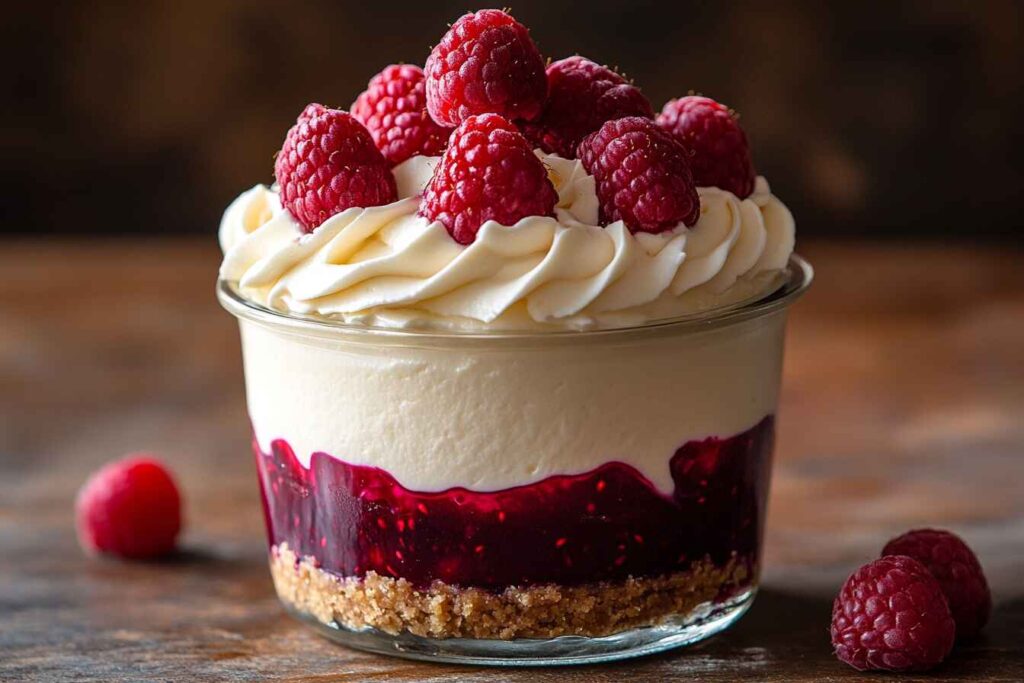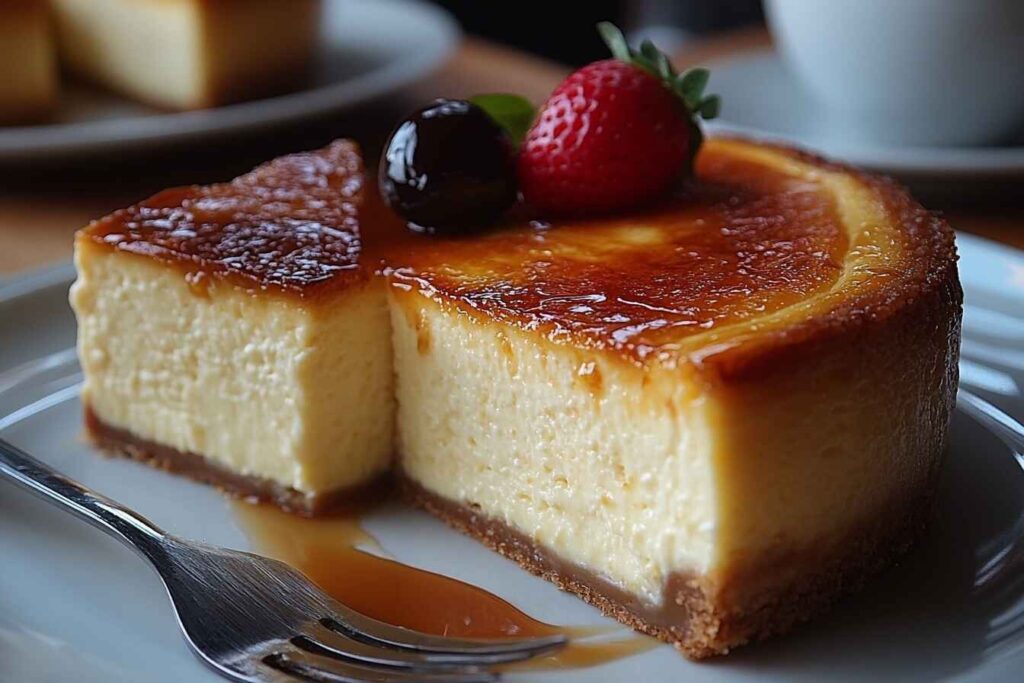Have you ever wondered, what are the three types of cheesecake? Cheesecake comes in many forms, but the three most popular types are New York-style cheesecake, no-bake cheesecake, and Japanese cheesecake. Each has its own unique texture, flavor, and baking method, making them perfect for different tastes and occasions.
In this ultimate guide, we’ll explore the differences between these cheesecakes, how to make them, and expert tips to avoid common baking mistakes. Whether you’re a fan of the dense and creamy New York cheesecake, the light and airy Japanese version, or the
Introduction: The Irresistible World of Cheesecake
Cheesecake isn’t just a dessert—it’s an experience! But what are the three types of cheesecake that every dessert lover should know? Imagine that first creamy bite melting in your mouth, the buttery crust adding the perfect crunch, and a topping that takes it to the next level. Whether you prefer New York-style cheesecake, the airy and delicate Japanese cheesecake, or a quick and easy no-bake cheesecake, each type has its own unique charm.
Cheesecake is more than just a sweet treat; it’s a favorite for birthdays, holidays, and celebrations. But what makes these three types of cheesecake different? Where did they come from, and which one is best for you? In this guide, we’ll dive deep into the history, flavors, and baking secrets behind these delicious desserts. If you’ve ever wondered, “What are the three types of cheesecake?,” you’re in the right place!
A Brief History of Cheesecake
Believe it or not, cheesecake has been around for over 4,000 years. The earliest recorded cheesecake dates back to ancient Greece. In fact, it was served to athletes during the first Olympic Games in 776 B.C. The Greeks believed it provided energy—so technically, cheesecake was once considered a health food!
Later, when the Romans conquered Greece, they adapted the recipe and spread it across Europe. Over the centuries, different cultures modified the recipe, leading to the variety of cheesecakes we enjoy today.
Fun Fact: Did you know that cream cheese—the key ingredient in most cheesecakes—wasn’t invented until the 1870s? A dairy farmer in New York accidentally created it while trying to make a different type of cheese.
Understanding the Three Main Types of Cheesecake
Now, let’s break down the three most popular types of cheesecake. Each has its own texture, preparation method, and flavor profile.
1. New York-Style Cheesecake
New York cheesecake is the king of cheesecakes. It’s rich, dense, and ultra-creamy, thanks to the heavy use of cream cheese, eggs, and sour cream. Unlike other cheesecakes, it has no fancy toppings—it’s all about the smooth, velvety texture.
Characteristics of New York-Style Cheesecake
- Thick and dense: This cheesecake holds its shape beautifully when sliced.
- Creamy and rich: The high-fat content gives it a luxurious texture.
- Baked in a water bath: This technique prevents cracks and ensures even cooking.
- Minimal toppings: New York-style cheesecake shines on its own, though some enjoy it with fresh fruit or a drizzle of caramel.
How to Make a Classic New York Cheesecake
Want to try making this legendary cheesecake at home? Here’s what you need:
| Ingredient | Quantity |
|---|---|
| Graham cracker crumbs | 2 cups |
| Butter (melted) | 1/2 cup |
| Cream cheese (room temperature) | 4 packs (32 oz) |
| Sugar | 1 cup |
| Eggs | 4 large |
| Sour cream | 1 cup |
| Vanilla extract | 1 tbsp |
| Lemon juice | 1 tbsp |
Instructions:
- Preheat your oven to 325°F (163°C).
- Mix graham cracker crumbs and melted butter, then press into a springform pan.
- Beat the cream cheese and sugar until smooth.
- Add eggs one at a time, followed by sour cream, vanilla, and lemon juice.
- Pour the batter over the crust and bake in a water bath for about 60 minutes.
- Let it cool, then refrigerate for at least 4 hours before serving.
Common Problems and Solutions When Baking New York Cheesecake
- Why does my cheesecake crack? Overbaking or rapid cooling can cause cracks. Use a water bath and cool it slowly.
- Why is my cheesecake too soft? Make sure to bake it long enough. It should jiggle slightly in the center but not be liquid.
- How do I prevent a soggy crust? Wrap the pan tightly with foil to keep water out.
2. No-Bake Cheesecake
If you love cheesecake but don’t want to deal with baking, no-bake cheesecake is your best friend! It’s creamy, light, and super easy to make.

What Makes No-Bake Cheesecake Different?
- Set in the fridge, not the oven: No eggs are required, so it firms up by chilling.
- Lighter and softer: The texture is mousse-like rather than dense.
- Perfect for summer: Since you don’t need to turn on the oven, it’s ideal for warm weather.
Step-by-Step Recipe for a Perfect No-Bake Cheesecake
| Ingredient | Quantity |
|---|---|
| Graham cracker crumbs | 2 cups |
| Butter (melted) | 1/2 cup |
| Cream cheese (room temperature) | 16 oz |
| Powdered sugar | 3/4 cup |
| Heavy whipping cream | 1 cup |
| Vanilla extract | 1 tsp |
Instructions:
- Combine graham cracker crumbs and butter, then press into a pan.
- Beat cream cheese and sugar until smooth.
- Whip heavy cream separately until stiff peaks form.
- Fold the whipped cream into the cream cheese mixture.
- Spread over the crust and refrigerate for at least 6 hours.
Pro Tip: For extra flavor, add lemon zest or swirl in fruit puree before chilling.
3. Japanese Cheesecake
Japanese cheesecake is unlike any other cheesecake you’ve tasted. It’s light, airy, and fluffy, almost like a cross between a souffle and a sponge cake. If you love soft, delicate desserts that melt in your mouth, this is the cheesecake for you!
What Is Japanese Cheesecake?
Japanese cheesecake, also known as soufflé cheesecake, is a masterpiece of baking. It doesn’t have the dense, creamy texture of New York-style cheesecake or the softness of a no-bake cheesecake. Instead, it’s **pillowy, jiggly, and light as air**.
The secret? Beaten egg whites. By folding stiffly beaten egg whites into the batter, you create a texture that’s soft, airy, and almost cloud-like.
How to Achieve the Light and Fluffy Texture
- Use room-temperature ingredients: Cold ingredients can prevent proper mixing.
- Whip the egg whites to stiff peaks: This gives the cheesecake its iconic fluffiness.
- Bake it in a water bath: This keeps the cake moist and prevents cracks.
- Cool slowly: A sudden temperature change can cause the cheesecake to collapse.
Japanese Cheesecake Recipe
| Ingredient | Quantity |
|---|---|
| Cream cheese | 8 oz |
| Butter | 2 tbsp |
| Milk | 1/2 cup |
| Eggs (separated) | 4 large |
| Sugar | 1/2 cup |
| Flour | 1/4 cup |
| Cornstarch | 1 tbsp |
| Lemon juice | 1 tsp |
| Vanilla extract | 1 tsp |
Instructions:
- Preheat your oven to 320°F (160°C). Line a round cake pan with parchment paper.
- In a double boiler, melt cream cheese, butter, and milk. Stir until smooth.
- Remove from heat, add egg yolks, flour, cornstarch, lemon juice, and vanilla extract.
- In a separate bowl, beat egg whites until foamy. Gradually add sugar and whip to stiff peaks.
- Gently fold the egg whites into the batter, being careful not to deflate the mixture.
- Pour the batter into the cake pan and place it in a water bath.
- Bake for about 60 minutes, then turn off the oven and let it cool inside.
Pro Tip: To test if your egg whites are beaten properly, turn the bowl upside down—if they don’t move, you’ve got stiff peaks!
Troubleshooting Common Japanese Cheesecake Issues
- Why did my cheesecake deflate? The most common reason is overmixing or cooling too quickly. Let it cool gradually in the oven with the door slightly open.
- Why is my cheesecake too dense? You may not have whipped the egg whites enough or folded them in gently.
- Why is my cheesecake cracked? If the oven temperature is too high, the cake may rise too fast and crack.
Other Popular Cheesecake Variations Around the World
While the three main types of cheesecake dominate dessert menus, there are **many other delicious versions** worth exploring. Let’s take a quick look at some unique cheesecakes from around the world.
Basque Burnt Cheesecake
Originating from Spain, **Basque burnt cheesecake** is famous for its dark, caramelized top. It’s baked at a high temperature, which creates a slightly burnt exterior while keeping the inside creamy.
Italian Ricotta Cheesecake
Unlike traditional cheesecakes made with cream cheese, **Italian cheesecake** uses **ricotta cheese**. This makes it lighter and slightly grainy in texture, with a more subtle sweetness.
Philadelphia-Style Cheesecake
Not to be confused with the brand **Philadelphia Cream Cheese**, this cheesecake is known for its **ultra-smooth texture**. It skips sour cream, making it **lighter and silkier** than New York-style cheesecake.
Choosing the Right Cheesecake for Your Taste
So, which cheesecake should you make? It all depends on your preference!
Comparing Texture, Flavor, and Baking Techniques
| Cheesecake Type | Texture | Flavor | Preparation |
|---|---|---|---|
| New York-Style | Thick, dense | Rich, creamy | Baked, water bath |
| No-Bake | Soft, mousse-like | Light, creamy | Chilled, no oven |
| Japanese | Fluffy, airy | Lightly sweet, eggy | Baked, water bath |
Best Cheesecake for Special Occasions
- For birthdays and celebrations: New York cheesecake is the perfect showstopper.
- For a quick and easy dessert: No-bake cheesecake is ideal.
- For something light and elegant: Japanese cheesecake is a great choice.
Fun Fact: The most expensive cheesecake in the world costs $5,000! It’s made with gold flakes, rare cheese, and a 200-year-old cognac.
Tips for Perfecting Your Cheesecake Recipes
Making cheesecake isn’t difficult, but small mistakes can lead to cracks, sinking, or a runny texture. Follow these expert tips to make the creamiest, most delicious cheesecake every time!
Ingredients That Make a Difference
- Use full-fat cream cheese: Low-fat versions won’t give you the same rich texture.
- Bring ingredients to room temperature: Cold cream cheese leads to lumps in your batter.
- Add a touch of cornstarch: This helps prevent cracking by stabilizing the filling.
- Use fresh eggs: They help bind the ingredients and create a smooth texture.
- Don’t overmix the batter: Overmixing adds air, which can cause the cheesecake to rise and fall.
Tools and Equipment for the Best Cheesecake Results
Having the right tools makes a huge difference in your cheesecake’s texture and presentation.
| Tool | Purpose |
|---|---|
| Springform Pan | Allows easy removal of the cheesecake. |
| Water Bath (Bain-Marie) | Prevents cracks by ensuring even baking. |
| Hand or Stand Mixer | Helps mix ingredients smoothly without overmixing. |
| Parchment Paper | Prevents the cheesecake from sticking to the pan. |
| Cooling Rack | Allows for gradual cooling to prevent sinking. |
Pro Tip: Always grease the sides of your springform pan to prevent sticking and cracking.
Storage and Serving Tips for Cheesecake
Cheesecake tastes even better the next day! But storing it correctly is key to keeping it fresh.
- Refrigerate properly: Store cheesecake in an airtight container to prevent it from absorbing fridge odors.
- Chill before serving: Cheesecake needs at least **4-6 hours** in the fridge to set properly.
- Use a hot knife for slicing: Run your knife under hot water, then wipe it dry for clean slices.

Common Cheesecake Baking and Storage Mistakes
Even experienced bakers can run into problems when making cheesecake. Here are the most common issues and how to fix them.
Cracked Cheesecake: Causes and Fixes
Nothing is more frustrating than pulling a cheesecake out of the oven, only to see cracks across the top. Here’s why it happens:
- Overbaking: Cheesecake should still be slightly jiggly in the center when you take it out.
- Skipping the water bath: A dry oven can cause the top to crack.
- Rapid cooling: Sudden temperature changes can make the cheesecake contract and crack.
How to fix it: If you notice cracks, cover them with fruit topping or whipped cream—it’s a delicious disguise!
Why Does My Cheesecake Sink in the Middle?
If your cheesecake collapses after cooling, here’s what went wrong:
- Underbaking: Cheesecake should be firm around the edges but slightly jiggly in the center.
- Overmixing: Too much air in the batter makes it rise too fast and then collapse.
- Opening the oven door too soon: A sudden drop in temperature can cause sinking.
How to fix it: Next time, bake it a little longer and let it cool slowly in the oven with the door slightly open.
How to Properly Store Cheesecake for Freshness
Cheesecake can last for days if stored correctly.
| Storage Method | How Long It Lasts |
|---|---|
| Refrigerator (covered) | Up to 5 days |
| Freezer (whole or sliced) | Up to 3 months |
How to freeze cheesecake:
- Let the cheesecake cool completely.
- Wrap it tightly in plastic wrap and then in foil.
- Label with the date and freeze for up to 3 months.
- Thaw overnight in the fridge before serving.
Conclusion: Exploring and Enjoying Cheesecake in All Forms
Now that you know about the three main types of cheesecake—**New York-style, no-bake, and Japanese**—you can decide which one suits your taste best. Whether you prefer the dense and creamy texture of a classic baked cheesecake or the light and fluffy feel of a Japanese version, there’s a cheesecake for everyone!
The key to a perfect cheesecake is **choosing the right ingredients, following the right techniques, and avoiding common mistakes**. With practice, you’ll be able to bake (or chill!) a flawless cheesecake that impresses family and friends.
Final Thought: Cheesecake is more than just a dessert—it’s a tradition, a science, and a delicious way to bring people together!
Now, it’s your turn! Which cheesecake will you try first? Let us know in the comments below!

